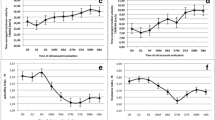Summary
In the 72 h after a single oral dose of 400 mg of the antiprogesterone mifepristone, 12 out of 14 first and one second trimester fetuses had a slight increase in heart rate; 2 fetuses died and one aborted. During the same 72 h, uterine activity increased moderately, and was physiological with no increase in resting pressure. The treatment sensitized the uterus to prostaglandin (PG) about ten-fold. A low, 0.05 mg IM, dose of sulprostone caused the demise of 5 more fetuses and caused the onset of clinical abortion in less than 2 h. After a relatively short hypertonic phase uterine resting pressure fell to normal levels and active contractions occurred leading to expulsion of uterine contents. The plasma level of progesterone (P) remained unaltered after mifepristone treatment, but the levels of estradiol 17b (E2) and cortisol increased. The plasma level of mifepristone was 1640±424 ng.ml −1 at 72 h, and the substance was still detectable after one week.
Similar content being viewed by others
References
Baulieu EE, Ulmann A, Philibert D (1987) Contragestion by antiprogestin RU 486: a review. Arch Gynecol Obstet 241:73–85
Bygdeman M, Swahn ML (1985) Progesterone receptor blockage effect on uterine contractility and early pregnancy. Contraception 32:45–51
Couzinet B, LeStrat N, Ulmann A, Baulieu E, Schaison G (1986) Termination of early pregnancy by the progesterone antagonist RU 486 (mifepristone). N Engl J Med 315:1565–1570
Csapo AI, Pulkkinen MO (1978) Indispensibility of the human corpus luteum in the maintenance of early pregnancy luteectomy evidence. Obstet Gynecol Surv 33:69–81
Csapo AI, Pulkkinen MO, Kaihola HL (1973) The effect of luteectomy-induced progesterone withdrawal on the oxytocin and prostaglandin response of the first trimester pregnant human uterus. Prostaglandins 4:421–429
Elger W, Bier S, Chwalisz K, Fohnrich M, Hasan SH, Henderson D, Neef G, Rohde R (1986) Studies on the mechanism of action of progesterone antagonists. J Steroid Biochem 25: 835–845
Karvai S, Nieman LK, Brondon DD, Udelsman R, Loriaux DL, Chrousos GP (1987) Pharmacokinetic properties of the antiglucocorticoid and antiprogesterone steroid RU 486 in man. J Pharmacol Exp Ther 241:401–406
Author information
Authors and Affiliations
Rights and permissions
About this article
Cite this article
Pulkkinen, M.O., Piiroinen, O. & Vainikka, J. A study of the effect of mifepristone (antiprogesterone) followed by prostaglandin on uterine activity and fetal heart rate in patients having a termination of pregnancy. Arch Gynecol Obstet 244, 75–78 (1989). https://doi.org/10.1007/BF00931376
Received:
Accepted:
Issue Date:
DOI: https://doi.org/10.1007/BF00931376



